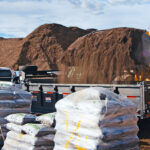
Sally Brown
BioCycle February 2015
I am willing to go down on record as saying that it is okay to burn plastic. Here I am not talking about the bottles that can be rinsed and recycled to make polar fleece jackets and composite decking. I am talking about the plastic wrap that has the smear of the leftover mashed potatoes on it. I am talking about the plastic bags that have the remnants of that bunch of cilantro turned to slime that didn’t come off when you put the main part of the bunch in the compost bin. I am talking about the stuff that makes up well over half of my trash. I am a poster person for recycling and composting — that should be obvious. But I still have residual plastics in my trash and burning them may be the best option out there.
I don’t buy what the recent New York Times article said about flat recycling rates and waste-to-energy (WTE) as the logical option. You build an incinerator for a billion dollars and that is a big incentive to reduce recycling rates even further. However some of the residual materials that even a poster person like myself generates might be better burned rather than landfilled.
Plastics are one of the myriad of products derived from fossil fuels. There is a range of types of these materials, including high density polyethylene (HDPE) and polyethylene terephtalate (PET) that are used to make bottles. These materials have the highest recycling rates — about 730,000 of the 2.68 million tons of PET and 220,000 of the 0.75 million tons of HDPE. Other types of materials include flexible packaging, trash bags, cups and plates, and wraps. For these materials recycling rates range from negligible to 10 percent.
Overall, 6.5 percent of the used plastics in the U.S. are recycled. About 8 percent are currently burned in WTE facilities and the remainder is landfilled. According to a report on the “Energy and Economic Value of Non-Recycled Plastics” produced by the Earth Engineering Center at Columbia University, close to 30 million tons of plastic are landfilled each year. In many cases recycling can be difficult because materials are from mixed types of plastic and are often soiled.
Making The Case
As plastics are derived from fossil fuels, their inherent energy value is similar to fossil fuels. And that is why combustion starts to sound like a possibility worth considering. The actual energy value of the specific type of plastic will depend on the carbon bonds in the material. That does not sound particularly exciting but what is exciting is that the range reported in the Columbia report is from 16.5 to 20.5 million Btu per ton.
This means that nonrecycled plastics have a lower energy value than c-rude oil or natural gas, but a higher value than coal. In other words, as long as we are still burning coal, and even if we are still processing crude oil, getting energy out of slimey plastic bags might just make sense. You could argue that landfilling these materials would store carbon so why talk about combustion. My response to that is that using these materials for energy would mean that we could leave a portion of the fossil reserves in the ground. That saves extraction costs and energy and seems to make a lot of sense.
The question then becomes where and how to burn the material. The report out of Columbia recommends large-scale WTE facilities. I can’t go for that. You spend $1 billion building a furnace and you are going to want to put more into it than Saran wrap. The report also discusses pyrolysis as an alternative means to get energy out of these materials. That might have some potential.
What, you may be asking, is happening to this person who you thought you knew, that same person who writes this column? First advocating combustion and then saying gasification might be okay? Pyrolysis facilities for combustion/ transformation of soiled and difficult to recycle plastics can likely be constructed at a fraction of the cost of large-scale WTE facilities. They can also be built to handle smaller volumes. And as the report notes, there is also the potential to create liquid fuels from this process. Pyrolysis of unrecycled and unrecyclable plastics could be a really attractive option.
The problem is that this is an option that is appropriate for a region that is close to reaching really ambitious recycling goals. Rather than the 30 percent flat rate that the New York Times reported as typical for most of the country, this is for a place like the San Francisco Bay area where recycling rates are pushing 80 percent. This is only a good answer for the places where food waste and yard trimmings are composted, and where metal, paper, glass and recyclable plastics are collected and made new. This is for the dregs of the waste stream. This would be a gift in my house and would bring us to close to 100 percent waste diversion. But if the high energy value of plastic is used as a justification for constructing a large scale high price waste-to-energy facility, that will suck up paper, cans, wood and food waste. That means we are getting it all wrong.
So think of this as an idea whose time has not quite come. It could come sooner by getting those recycling rates up past 50 percent. Or perhaps, develop a kitchen model pyrolysis unit?
Sally Brown is a Research Associate Professor at the University of Washington in Seattle and a member of BioCycle’s Editorial Board.












